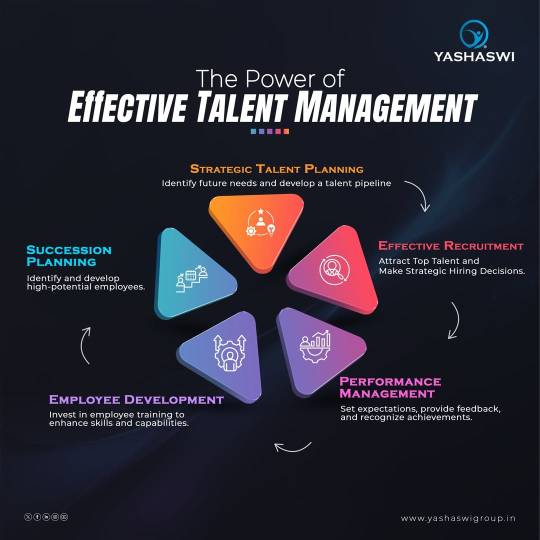#talent management strategies
Explore tagged Tumblr posts
Text
Human Resource Services | Tata Steel Industrial Consulting Optimize your workforce with Tata Steel Industrial Consulting's Human Resource Services. From talent acquisition and employee development to performance management and HR strategy, our expert solutions drive organizational success. Elevate your HR practices today and achieve sustainable growth.
#human resource development#leadership development programs#workplace wellness programs#employee relations management#employee engagement strategies#talent management strategies#workplace programs#Tata Steel Industrial Consulting#TSIC
0 notes
Text
#talent management#talent management strategies#business consultants#business management consultant#management consulting
0 notes
Text
Talent Acquisition and Management in HRM

Streamline everything from onboarding, induction to campus hiring with our deft talent management strategies. Connect with us today to become the brand of choice.
#talent management#talent management process#talent management in hrm#talent management strategy#talent management strategies#hr management#hrm management
1 note
·
View note
Link
HR strategies are essential for any business. They help create a positive work environment, ensure compliance, and increase employee engagement and productivity.
#hr professional#hrm#hrstrategy#hrstrategies#employee retention#talent management#talent management strategies#human resources management#employees#employee#employeerecognition#employee benefits#Human Resource#Human Resources
0 notes
Text
Do you want updated handbooks? Do you want to build compliance among employees? One solution to all your problems! Invest in your HR team's development! We equip HR professionals with the skills and knowledge needed. They excel in their roles and will help you excel too!
2 notes
·
View notes
Text
Revolutionizing Talent Management Strategy for Success: A Blueprint for HR Excellence
Revolutionizing Talent Management Strategy for Success: A Blueprint for HR Excellence In the dynamic landscape of today’s business world, the concept of talent management has emerged as a cornerstone of organizational success. Talent Management, a multifaceted discipline within human resources, focuses on the strategic handling of a…
0 notes
Text
How International Executive Search Firms Can Help Enterprises Prepare for the Future?
International executive search firms play a crucial role in helping businesses navigate the evolving global landscape. By leveraging their expertise and global networks, these firms can identify and recruit top-tier leadership talent that aligns with an organization’s long-term vision. They help enterprises stay competitive by sourcing executives with the right skills, experience, and cultural fit for international markets.
These firms also offer valuable insights into emerging trends and leadership best practices, ensuring companies remain agile and forward-thinking. Through strategic talent acquisition, international executive search firms empower enterprises to adapt to future challenges, drive innovation, and maintain sustainable growth. Their ability to scout top executives across diverse markets enables companies to build strong, diverse leadership teams that are essential for success in a dynamic business environment. For more information click here
#International Executive Search#Talent Acquisition#Leadership Development#Global Workforce#Executive Recruitment#Strategic Hiring#Business Growth#Global Talent#Future of Work#Executive Search Firms#Leadership Strategy#Organizational Development#Talent Management#Global Expansion#Innovation in Hiring
0 notes
Text
Why Adaptability Is Crucial for Leadership Success
In today’s fast-paced and ever-changing business world, leaders face the ongoing challenge of navigating uncertainty and driving their teams toward success. Adaptability has emerged as one of the most critical traits for effective leadership. At Loeb Leadership, we believe that cultivating adaptability is not just a skill but a cornerstone of any successful talent management strategy.
Understanding Adaptability in Leadership
Adaptability is the ability to adjust to new conditions, embrace change, and thrive under evolving circumstances. For leaders, it goes beyond just responding to external shifts—it’s about proactively anticipating challenges and opportunities and steering the team in the right direction.
So, Why is Adaptability Important in leadership? The answer lies in its profound impact on decision-making, team morale, and organizational growth. Leaders who adapt effectively can:
Respond to Market Trends: Adaptable leaders can pivot strategies to meet emerging customer demands in a rapidly shifting marketplace.
Inspire Resilience: Leaders instill confidence and resilience in their teams by modeling flexibility and calm under pressure.
Encourage Innovation: Adaptable leaders are open to new ideas, fostering a culture of creativity and problem-solving within the organization.
Navigate Crises: Adaptable leaders can quickly assess situations and implement effective solutions, whether it's economic uncertainty or unforeseen challenges.
Adaptability as a Pillar of Talent Management Strategy
Incorporating adaptability into your Talent Management Strategy is essential for building a team capable of sustaining long-term success. Loeb Leadership offers expert insights and tools to help organizations embed adaptability within their leadership frameworks. Here’s how:
Assessing Potential: When hiring or promoting leaders, look for candidates who demonstrate a track record of handling change and ambiguity effectively. Behavioral interviews and situational assessments can uncover these traits.
Ongoing Development: Invest in training programs focused on developing emotional intelligence, agility, and resilience. These skills are directly linked to adaptability.
Creating a Supportive Environment: Encourage open communication and collaboration, where team members feel empowered to share ideas and adapt to new roles or responsibilities.
Recognizing Growth: Reward leaders who demonstrate adaptability in their roles. This reinforcement solidifies the importance of the trait within your organizational culture.
The Loeb Leadership Approach to Adaptability
At Loeb Leadership, we understand that adaptability doesn’t happen overnight. Our tailored coaching and leadership development programs focus on equipping leaders with the tools they need to navigate change effectively. We emphasize self-awareness, emotional intelligence, and strategic thinking—all essential components of adaptability.
Moreover, we recognize that adaptability must be ingrained at every organizational level. From executives to team leads, fostering an adaptable mindset ensures cohesive strategies and a unified approach to challenges.
Final Thoughts
Adaptability isn’t just a buzzword; it’s a vital competency for leadership in today’s dynamic business landscape. By integrating adaptability into your talent management strategy, you empower your organization to remain resilient and competitive, regardless of external pressures. At Loeb Leadership, we’re committed to helping organizations and leaders excel by embracing this indispensable trait.
If you’re ready to take your leadership and talent management strategy to the next level, explore our insights and resources at Loeb Leadership.
0 notes
Text
The Importance of Effective Talent Management for Organizational Success

Previously, businesses thrived entirely on their products and services. But times have changed. Today, the real conflict is the talent competition. Organizations can increase performance, obtain a competitive advantage, and succeed over the long run with efficient talent management. It is no longer only an HR job; it is a strategic requirement with a significant impact on a company’s success. Increasing productivity, decreasing turnover, and fostering creativity are just a few of the advantages that organizations may reap by successfully luring, nurturing, and retaining performing employees.
What is Talent Management?
It’s a systematic approach to improving an organization’s human resources that includes a variety of HR strategies such as talent acquisition, skill development, performance management, succession planning, and retention. Organizations may enhance employee engagement, increase productivity, and cultivate a high-performance culture by managing personnel well.
Here are some key benefits that highlight its importance.
Enhanced Organisational Performance:
A trained and motivated workforce is the foundation for corporate success. Organizations that systematically acquire, develop, and retain outstanding personnel can greatly increase their overall performance.
Improved Employee Retention:
A well-executed talent management plan promotes a healthy work environment and increases employee loyalty and happiness. Organizations can reduce turnover by providing opportunities for professional growth, development, and recognition.
Better Engagement of Workers:
Employees who are engaged are more productive, imaginative, and committed to their organization’s goals. Regular performance reviews, career development planning, and efficient communication are examples of talent management strategies that can greatly improve employee engagement and morale.
Futureproofing:
A proactive approach to talent management enables firms to discover and nurture future leaders. Organizations are ensuring their workforce is prepared to adjust to shifting market trends and company needs by investing in learning and development.
Best Practices for Talent Management:
Consider these essential best practices for optimizing talent management.
Use Data Driven Decisions:
Analyse data to better understand workforce trends, identify talent gaps, and evaluate the efficacy of talent initiatives. Use these findings to create well-informed recruitment, development, and retention strategies. For instance, examining turnover rates can reveal opportunities to improve employee engagement and happiness.
Continuous Learning Opportunities:
Invest in continuous training and development initiatives to upskill and reskill your personnel. This improves staff capacities while also increasing morale and engagement. Create individualized growth plans, mentorship programs, and possibilities for professional progression.
Diversity and Inclusion:
Create a workplace culture that values diversity, equity, and inclusion, ensuring that each employee feels appreciated, respected, and empowered. This may be accomplished by bringing in people from a variety of backgrounds, offering equitable chances for professional advancement, and fostering a feeling of community inside the company. A diverse workforce provides distinct viewpoints, resulting in increased creativity, innovation, and more effective problem solutions. By developing such an open atmosphere, organizations can unleash their workers’ full potential and create a vibrant, forward-thinking company.
Performance Monitoring and Feedback:
Establish a strong performance management system that includes frequent performance evaluations, goal setting, and feedback. This facilitates the alignment of individual goals with corporate objectives, the recognition and reward of top performers, and the proactive resolution of performance difficulties.
Employee Experience:
By creating a good and supportive work environment. This involves providing flexible work arrangements, comprehensive and competitive remuneration and benefits, and encouraging a positive work-life balance. An environment where workers feel appreciated and supported raises job satisfaction, boosts productivity, and increases employee retention. Prioritizing employee well-being not only boosts morale but also fosters a loyal and engaged staff, which supports long-term growth.
Elevate Your Workforce with Effective Talent Management
Effective personnel management is no longer a luxury; it is an essential component of corporate success. Organizations that deliberately acquire, develop, and retain people may improve performance, increase employee retention, promote engagement, and future-proof their workforce. These initiatives promote innovation, adaptation, and resilience, allowing firms to prosper in today’s competitive environment. Companies that prioritize continuous learning, diversity, performance management, and a great employee experience may build a high-performing, engaged staff that drives long-term success.
#talent management#Workforce management#Human resource management#Talent development#Performance management#Employee engagement#Succession planning#Talent optimization#HR solutions#Recruitment strategy
0 notes
Text
Leadership Development in Hotel Management

The hospitality industry is built on exceptional service, smooth operations, and innovative thinking. Leadership in hotel management plays a critical role in ensuring everything runs seamlessly while creating memorable experiences for guests. For those aiming for managerial or executive positions, developing strong leadership skills is essential for success in this competitive, ever-changing global market.
Effective leadership ensures
Increased employee satisfaction and retention
Higher guest satisfaction and loyalty
Streamlined operations and improved profitability
The ability to adapt to industry disruptions and trends
Key Areas of Leadership Development in Hotel Management
1. Operational Excellence – Leaders in hotel management oversee various operational aspects, from housekeeping and front desk operations to food and beverage services. Effective training in operational leadership ensures that managers can optimize efficiency while maintaining high service standards.
2. Customer-Centric Approach – Exceptional guest experiences are at the heart of hospitality. Leadership programs focus on developing interpersonal skills, emotional intelligence, and problem-solving abilities, enabling leaders to handle guest concerns with professionalism and empathy.
3. Team Management – Hotels often employ a large and diverse workforce. Leadership training emphasizes communication, delegation, and motivational skills to foster collaboration and drive team performance.
4. Strategic Thinking – Leaders are trained to analyze market trends, understand customer preferences, and implement strategies to maintain a competitive edge. This includes revenue management, marketing, and innovation in service delivery.
5. Sustainability and Digital Transformation – Modern hotel management integrates sustainable practices and technology-driven solutions. Leadership development programs prepare managers to implement green initiatives and leverage digital tools like property management systems and CRM software to enhance efficiency.
6. Crisis Management – From natural disasters to guest complaints, hotel managers must be adept at handling crises. Leadership programs include training in risk assessment, decision-making, and maintaining calm under pressure.
How to Cultivate Leadership in Hotel Management
Educational Programs Pursuing a specialized degree or MBA in Hospitality Management offers foundational knowledge and leadership-focused coursework tailored to the hotel industry.
On-the-Job Training Practical experience is invaluable. Many hotels offer leadership training programs where employees can learn by managing real-world scenarios under the guidance of experienced mentors.
Workshops and Seminars Regular workshops and industry seminars provide insights into emerging trends, new technologies, and global best practices.
Networking Opportunities Connecting with industry leaders and peers helps aspiring managers gain diverse perspectives and mentorship opportunities.
Soft Skill Development Focusing on communication, negotiation, and conflict resolution skills is essential for successful leadership.
Strong leadership is at the heart of any successful hotel. It’s the leaders who make sure guests have memorable experiences and that everything runs smoothly behind the scenes. If you’re aiming to take on a leadership role in the hospitality industry, investing in leadership training is essential for opening up new opportunities and building a lasting career. At Chennais Amirta, we’re all about helping you develop the skills you need to thrive in this fast-paced industry. Our Hotel Management Programs are designed to prepare you for real-world challenges, setting you up for success in a career that’s always evolving!
#leadership development#hotel management#hospitality leadership#professional growth in hospitality#management training#hotel industry skills#leadership strategies#career advancement in hotels#hospitality leadership programs#hotel management education#professional development#hospitality workforce training#executive skills in hospitality#hotel leadership techniques#talent development#hospitality management careers#leadership qualities#hotel industry leadership#professional skills training#career progression in hotels#hospitality management best practices#leadership coaching#hotel staff development#management excellence#hospitality industry trends
1 note
·
View note
Text

TruFynd is India’s premier recruitment agency, offering specialized staffing and HR solutions in IT, Non-IT, and manpower consultancy. With innovative recruitment strategies and tailored services, we help businesses find top talent while providing job seekers with exclusive career opportunities.
#TruFynd#recruitment agency India#HR solutions#staffing services#IT recruitment#non-IT recruitment#manpower consultancy#job placement services#executive search#payroll management#bulk hiring#leadership talent#recruitment companies India#job seekers#HR consultancy#recruitment solutions#talent acquisition#recruitment services#career opportunities#HR consulting firms#innovative recruitment strategies
1 note
·
View note
Text
The rise of the Chief AI Officer: Is your organization ready?
New Post has been published on https://thedigitalinsider.com/the-rise-of-the-chief-ai-officer-is-your-organization-ready/
The rise of the Chief AI Officer: Is your organization ready?

Imagine this: It’s 2025. The CEO of a mid-sized tech company, overwhelmed by the rapid changes in AI, realizes the company is missing out. Despite having the latest tools and software, there’s still a gap—a missing strategic vision to make it all work seamlessly.
That’s when they decide to hire a Chief AI Officer. Within a year, the company transforms. Customer satisfaction is up, operations are smoother, and new revenue streams have opened. The CAIO didn’t just bring AI; they brought a revolution.
Artificial intelligence has evolved from an experimental technology to a core business necessity, reshaping operations, decision-making, and customer experiences. As its influence grows, so does the need for specialized leadership.
Enter the Chief AI Officer (CAIO), a role dedicated to embedding AI into the organization’s DNA. But what exactly does this role bring to the table that other tech executives might not?
Why a Chief AI Officer?
In many companies, AI initiatives have traditionally been managed by IT departments or overseen by roles like the Chief Data Officer (CDO) or Chief Technology Officer (CTO).
However, as AI’s impact broadens, the demand for dedicated AI leadership becomes clearer. A CAIO does more than oversee implementation; they shape how AI integrates with the organization’s core functions and long-term objectives.
Several critical factors underscore the rise of this role:
Specialized expertise in emerging AI applications: Implementing AI at a strategic level requires not only technical knowledge but also industry-specific insights. CAIOs need to stay ahead of AI’s evolving applications, including in non-traditional sectors like education, nonprofits, and disaster response. A CAIO with insights into these fields can tailor innovations to meet unique industry challenges, creating a distinct competitive advantage.
Ethical and regulatory leadership: AI’s rapid adoption introduces pressing ethical and regulatory issues, from privacy concerns to managing bias. CAIOs play a crucial role in ensuring that AI systems adhere to ethical principles, such as those outlined in the UNESCO Recommendation on the Ethics of Artificial Intelligence. By establishing clear guidelines and monitoring AI’s impact, CAIOs can help mitigate potential harms, promote transparency, and foster public trust—elements critical for organizations that seek to lead responsibly in AI.
Driving business transformation: The CAIO’s role goes beyond introducing AI tools; it’s about transforming business processes, opening new revenue streams, and improving customer experience. For instance, the grant proposal tool I implemented reduced preparation time by over 30 hours per proposal, illustrating the kind of measurable impact that a CAIO can bring. Positioned at the executive level, the CAIO drives AI initiatives that create significant, lasting change.
Workforce development and transformation: The demand for AI talent is high, and a CAIO is essential in attracting, developing, and retaining team members who can deliver on AI strategies. They foster an AI-savvy culture that integrates technical and business knowledge across the workforce. By prioritizing internal training and upskilling, CAIOs can help employees embrace AI as a valuable tool, not a threat.
Cross-departmental integration: AI’s reach extends to every corner of a business, impacting marketing, customer service, HR, and beyond. A CAIO ensures that AI adoption is cohesive and strategic, breaking down departmental silos to drive alignment with the company’s goals. For example, implementing an AI recommendation engine across product development and customer service can streamline and enhance the entire customer journey, delivering value at every touchpoint.

Key responsibilities of a Chief AI Officer
A CAIO’s responsibilities are diverse and strategic, encompassing the oversight of AI initiatives, risk management, and performance measurement. Key duties include:
Strategic planning: Develop a clear AI vision, prioritize high-impact projects, and collaborate with other executives to ensure AI initiatives align with organizational goals. Strategic planning with a CAIO is about more than timelines; it’s about identifying projects that will have meaningful, transformative impact.
Implementation oversight: Oversee the end-to-end development and deployment of AI initiatives, ensuring each project—from model design to deployment—meets strategic objectives. CAIOs prioritize high-ROI projects and track their success to showcase AI’s tangible value within the organization.
Governance and ethics: Establish ethical governance frameworks to manage biases, protect data privacy, and adhere to regulations, embedding responsible AI practices within the organization’s culture. In my work developing governance frameworks, I’ve built models to track and mitigate bias, highlighting that ethical AI governance is an ongoing process, not a one-time setup.
Change management and education: Drive AI adoption across the organization by addressing concerns, promoting understanding, and providing upskilling opportunities. Educating employees about AI’s benefits is critical for fostering acceptance and creating a culture where AI is seen as empowering, not disruptive.
Performance measurement and iteration: Set and monitor metrics—such as efficiency gains, revenue impact, and customer satisfaction improvements—to assess AI’s success. CAIOs continuously refine AI strategies to adapt to technological advancements, making performance measurement a cornerstone of AI leadership.
Is a CAIO right for your organization?
Not every organization may need a dedicated CAIO. For smaller businesses or those with limited AI applications, roles like the CTO or CDO might sufficiently cover AI needs.
However, companies with ambitious AI goals—especially in complex or regulated sectors like finance, healthcare, or retail—can gain substantial value from having a CAIO to focus on AI’s strategic alignment, ethical oversight, and cohesive deployment.
For organizations that aren’t yet ready to bring on a CAIO, developing CAIO-like responsibilities within existing roles can serve as a bridge. This approach prepares the organization to navigate AI’s growing influence, positioning it to embrace a future where the CAIO role might become essential.
The CAIO doesn’t just drive AI strategy; they align AI initiatives with the broader business vision, ensuring that implementations are impactful, ethical, and compliant. In an era where AI is integral to business success, a CAIO’s focused leadership could be the competitive edge that organizations need to stay ahead.
Conclusion
The emergence of the Chief AI Officer marks a pivotal shift in business, where AI becomes a strategic driver of innovation and a core element of corporate vision.
For organizations committed to responsible, comprehensive AI adoption, a CAIO can be the catalyst that unites people, processes, and technology, future-proofing the organization in an AI-powered world.
Transforming customer experiences, developing an AI-capable workforce, and establishing ethical standards, a Chief AI Officer (CAIO) plays a crucial role in driving the change needed to navigate today’s ever-evolving AI landscape.
Want more from Dr. Denise Turley?
Check out her other articles below:
Dr. Denise Turley – AI Accelerator Institute
Dr. Denise Turley integrates AI in academia and industry. As a speaker, she promotes diversity and inclusion, supporting women in tech through mentorship and policies for equitable opportunities.


Like what you see? Then check out tonnes more.
From exclusive content by industry experts and an ever-increasing bank of real world use cases, to 80+ deep-dive summit presentations, our membership plans are packed with awesome AI resources.
Subscribe now
#adoption#ai#AI adoption#AI strategy#AI systems#ai talent#ai tools#AI-powered#applications#approach#Articles#artificial#Artificial Intelligence#bank#Bias#bridge#Business#catalyst#CDO#CEO#change#change management#chief AI officer#chief data officer#collaborate#Companies#comprehensive#content#CTO#customer experience
0 notes
Text
Shaping the Future of Human Resource Leadership

The Global Council of HR Leaders (GCHR) serves as a platform for HR professionals worldwide to collaborate, share knowledge, and lead the evolution of human resource management and leadership.
#Human resources#HR leadership#HR management#HR professionals#Talent management#Global HR practices#Employee engagement#HR strategy#Organizational development#HR innovation#Leadership development#Workforce planning#Performance management#Employee training#Compensation and benefits#Diversity and inclusion
0 notes
Text
Corporate HR Function – Responsibilities and Limitations I – Asrar Qureshi’s Blog Post #1013
#Asrar Qureshi#Blogpost1013#Challenges#Effectiveness#Employee Engagement#HR management#Human Resource#Performance Management#Pharma Veterans#Talent Strategy
0 notes
Link
HR certification online usually can make a lot of difference, but among them there are a few best HR certifications that recruiters prefer and these HR certifications impact a lot in their decision making to hire the HR professionals.
#HR Certifications#hr certification#employee#employees#talent management#human resources management#talent management strategies#employee retention
0 notes
Text
Forex trading strategies
Discover effective Forex trading strategies with Axe Trader to boost your success in the currency markets. Learn how to trade using proven methods like scalping, day trading, swing trading, and more at: https://www.axetrader.com/forex-trading-strategies

#forextradingstrategies #bestpropfirms #smartproptrader #forex #fundednext #forextrading #trading #riskmanagement #proptrading #propfirm #usa #unitedstates #axetrader
#Forex trading strategies#prop firms#funded trading accounts#cheapest prop firms#trading risk management#instant funding prop firm#the talented trader#proprietary trading firm#prop firm trading#prop firm challenge#prop firms instant funding#martingale strategy#scalping trading strategy#Axe Trader
0 notes